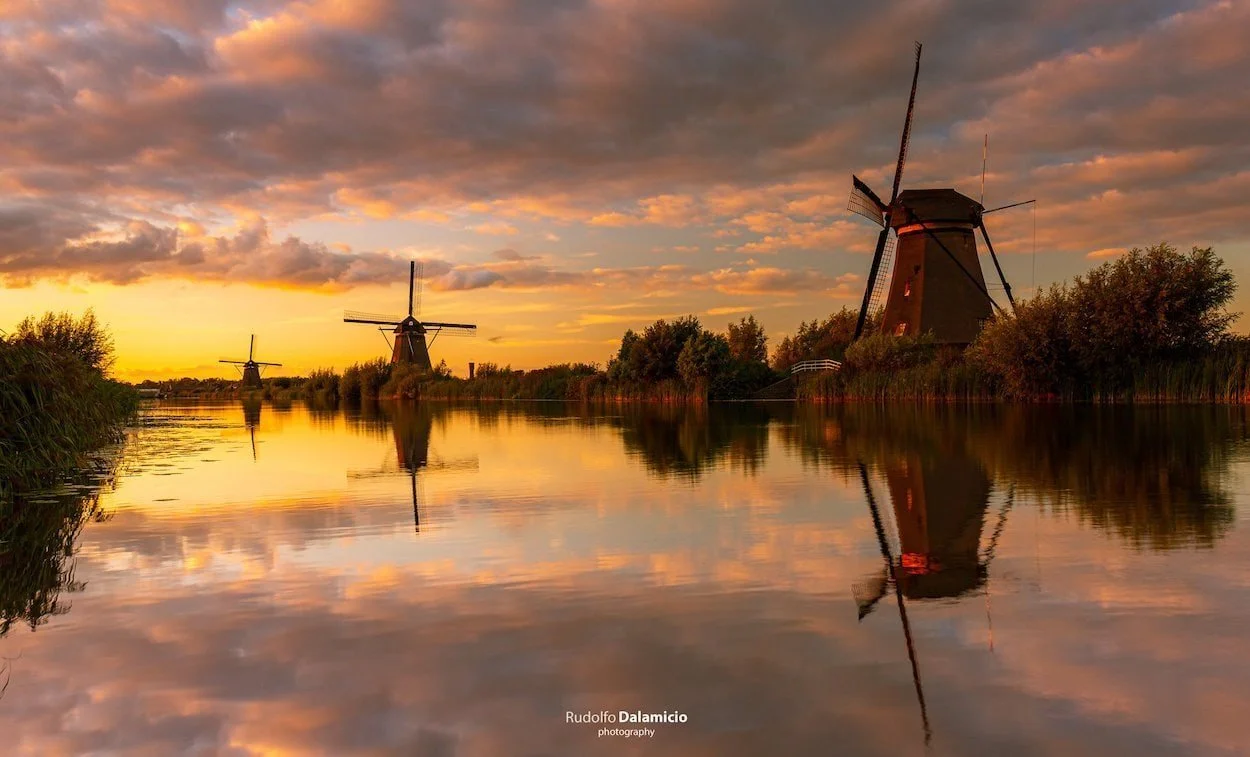Landscape Photography from The Netherlands: Capturing Dutch Natural Beauty
Your Guide to Photography in the Netherlands - Best tips for excellent results
With just 33893 km3 of land and 17.6M people, we are one of the most dense countries of the world. That being said, we do have 139.294! km of streets, so we get around quit fast. Perfect to move around the The Netherlands by car and plan your photography trip to capture all that stunning dutch landscapes!
Capturing the Essence of Dutch Landscapes
The Netherlands boasts an incredibly diverse range of landscapes, from vast expanses of flatlands to intricate networks of canals and waterways. Some of its most captivating features are its flat landscapes, tulip fields, and agriculture. In this section, we will delve into how photography captures the essence of these unique Dutch landscapes.
Flat Landscapes and Vast Skies
The Netherlands is known for its flat landscapes, which make up a large portion of the country's geography. This absence of mountains and hills offers photographers a unique opportunity to capture sweeping panoramas and the distinction between land and sky. The interaction between clouds, sunlight, and shadows creates a dynamic backdrop for these impressive landscapes, resulting in images that showcase the vastness and openness of the Dutch countryside. The low horizon also allows for incredible sunrises and sunsets, with vibrant colors painting the sky and reflecting on the flat terrain below.
Waterways and Canals
In addition to flat landscapes, the Netherlands is famous for its intricate network of canals and waterways. These water features offer photographers interesting reflections, balanced compositions, and a variety of elements to incorporate into their images. The abundant bridges and buildings lining the canals provide a unique combination of nature and urban architecture, while the reflections in the water create symmetry and harmony. Additionally, the canals and waterways lend themselves to captivating long exposure photography, with the movement of boats and water captured in a single, dream-like image.
Tulip Fields and Agriculture
Agriculture plays a central role in Dutch landscapes, and the tulip fields are arguably the most iconic representation of this. The vast expanses of vibrant colors create an enchanting sight, and photographers can capture the patterns, textures, and contrasts that abound in these fields. The rows of tulips form compelling leading lines, drawing the eye deeper into the scene. The sheer scale of these fields makes aerial photography particularly striking, providing a bird's-eye view of this unique landscape feature.
In summary, the diverse and beautiful landscapes of the Netherlands offer photographers a plethora of opportunities to capture stunning images. From vast skies and flat terrains to intricate waterways and colorful tulip fields, the essence of Dutch landscapes is undeniable and continues to inspire photographers from around the world.
Iconic Locations for Landscape Photography
Kinderdijk
Kinderdijk is known for its iconic windmills, which were built in the 18th century to drain the surrounding area and prevent flooding. This UNESCO World Heritage site provides a perfect backdrop for landscape photographers, with its historic windmills standing tall against the Dutch countryside.
Zaanse Schans
Zaanse Schans preserves a piece of the old Netherlands, where wooden houses, windmills, and workshops make up a picturesque landscape. This historic village also features a working dye mill, a sawmill, and an oil mill providing opportunities to capture the essence of Dutch history and tradition.
Giethoorn
Often referred to as the "Venice of the North", Giethoorn is characterized by its picturesque canals, thatched-roof cottages, and lush gardens. With no roads in the village, transportation is exclusively by boat or walking along the wooden footbridges that connect the homes. This tranquil setting, steeped in natural beauty, provides landscape photographers with countless opportunities to capture idyllic water scenes and unique village life.
Veluwe
The Veluwe region in central Netherlands is an expansive area of forest, heathland, and sand dunes. Seasonal changes in the landscape such as flowering heather, colorful foliage, and frosted landscapes offer a diverse range of photographic opportunities. Popular spots within the Veluwe region include the Hoge Veluwe National Park and the Kootwijkerzand sand dunes. Wildlife, such as red deer, wild boar, and numerous bird species, can also be captured in this rich natural environment. Here is my latest work on wild horses at the Posbank
Techniques and Tips for Dutch Landscape Photography
Composing Minimalistic Shots
Dutch landscape photography is known for its emphasis on minimalism and simplicity. To create a minimalistic shot, focus on selecting a strong, central subject and eliminate any distractions from the frame. Framing your subject with the rule of thirds is a useful tool for creating balance within your composition. Use negative space to bring attention to your subject and evoke a sense of tranquility and openness in the image. Additionally, consider incorporating leading lines and repeating patterns to guide the viewer's eye through the photograph.
Working with Natural Light
Natural light plays a crucial role in the aesthetics of Dutch landscape photography. Take advantage of the golden hours – early morning and late afternoon – for soft, warm light that brings out rich colors and casts long shadows. During the day, overcast skies can provide diffused lighting that minimizes harsh shadows and evenly illuminates your subject. When photographing water, use reflections and backlighting to create interesting visual effects. Be mindful of the direction of light and how it affects the mood and textures in your image, experimenting with side-lighting and backlighting for depth and contrast.
Capturing Seasonal Scenes
The Netherlands offers diverse seasonal landscapes, and taking advantage of these changes can result in captivating images. In the spring, capture blooming tulip fields and fresh greenery for vibrant shots filled with color. Summer provides opportunities for sunlit meadows and coastal images, while autumn showcases forests adorned with rich, warm hues. Winter landscapes can be equally enchanting, with frosty mornings and snow-covered scenes making for unique and atmospheric images. Remain adaptable and aware of the changing seasons and plan your photography outings accordingly to capture the essence of each season in your Dutch landscape photographs.
Dealing with Dutch Weather and Climate
Preparing for Unpredictable Weather
In the Netherlands, the weather is known to be unpredictable, so photographers must be prepared for various conditions. Layers and waterproof clothing are essential for staying dry and warm when the rain starts to fall or when temperatures drop without warning. Checking the local forecast daily is crucial in anticipating and planning for potential changes. Incorporating the Dutch winter landscape into photographs can provide stunning contrasts between the traditional architecture or pastoral scenes and the dramatic weather.
stormy moving clouds in The Netherlands
Maximizing the Golden Hour
The golden hour, which occurs shortly after sunrise and before sunset, provides perfect lighting conditions for landscape photography. The warm, soft light enhances the colors and casts longer shadows, adding depth and texture to the scene. In the Netherlands, the sun sets relatively early in the winter months, providing opportunities for photographers to capture the unique beauty of the Dutch countryside. It is essential to use a tripod during these low light situations to avoid camera shake and ensure sharp images.
Photographing in Fog
Fog can transform the Dutch landscape into an ethereal and enchanting scene, creating layers and depth that capture the viewer's attention. As the fog typically sets in early morning or late afternoon, it is crucial to plan these photo sessions accordingly. To maximize the impact of fog in landscape photography, photographers should use manual focus. Auto-focus systems can struggle to find and lock onto a subject when visibility is low. Also, using a shallow depth of field can help isolate the subject and create a mystifying atmosphere. Experimenting with different compositions and perspectives can lead to compelling and captivating images that embody the essence of the foggy Dutch landscape.
Required Gear and Equipment
Choosing the Right Camera
The choice of a suitable camera is crucial for landscape photography in the Netherlands. A reliable camera that performs well in various weather conditions can make a significant difference. It is essential to select a camera with a solid build, good weather sealing, and excellent image quality. Most modern DSLRs or mirrorless cameras can produce stunning landscape photographs, as mentioned by Lightstalking. Additionally, having a lightweight, pocketable second camera can be beneficial when exploring the picturesque scenery of the Netherlands.
Selecting Suitable Lenses
A wide-angle lens is highly recommended for capturing the stunning landscapes of the Netherlands. The most popular choice for landscape photographers is the 17-35mm wide-angle zoom (full-frame or equivalent) due to its versatility and precision, as noted by Nature TTL. These lenses enable photographers to capture sweeping panoramas, vast tulip fields, and quaint Dutch villages in great detail. It is vital to consider factors such as weight, size, and distortion when choosing the perfect lens for this type of photography.
Tripods and Filters
Tripods: A solid, stable tripod is essential for sharp, well-composed images, especially when shooting with slower shutter speeds or under low-light conditions. A tripod with sturdy legs and a reliable ball head will ensure crisp, blur-free shots. In addition, a lightweight, portable tripod can be useful when traveling across the Netherlands' various landscapes.
Filters: Filters are an indispensable addition to any landscape photographer's gear kit. Polarizing filters can help to enhance colors, reduce glare, and increase contrast in the dramatic skies of the Netherlands. Neutral density filters can be employed for creative long exposure photography, allowing for silky smooth water effects and motion blur in windmill shots. Graduated neutral density filters are helpful for balancing exposures in high-contrast scenes, such as sunsets over the Dutch coastline.
Now I hope this gives you even more confidence to get out there and start planning your next incredible photo! Keep on looking and until next time.
Regards Rudolfo Dalamicio
“Seeing things through a lens, shapes the world into your own vision”


